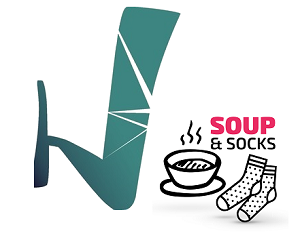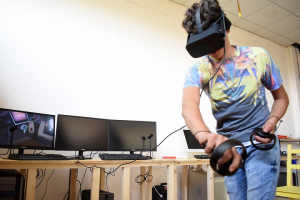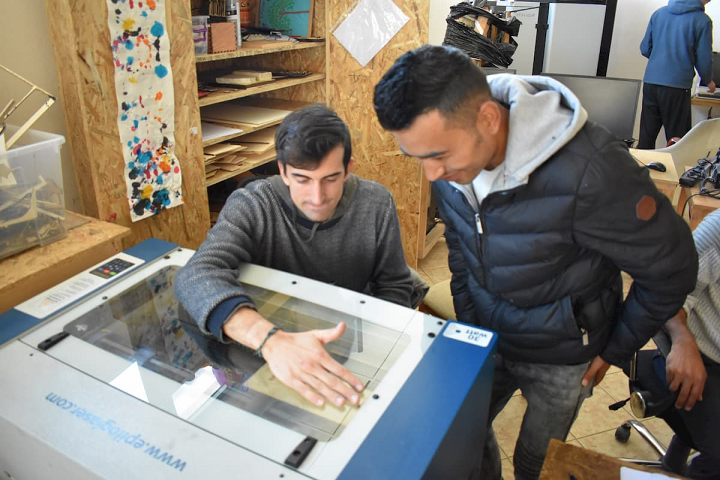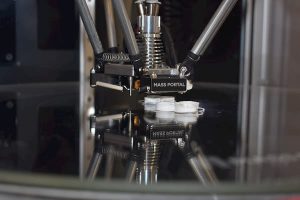Greek Refugees Using Mass Portal 3D Printer, Donated by Materialise, to Design and Print Their Own Models
We often hear heartwarming stories of how 3D printing is being used to make the world a better place in all sorts of ways. In 2016, German NGO Soup & Socks eV founded an intercultural fab lab, or makerspace, called Habibi.Works, which provides platforms for everyday education and empowerment to thousands of refugees, and the local community, in Katsikas, Greece.
“One of our strongest values in Habibi.works is that we work with people to find solutions to their problems,” explained Saad Abouchadi, who has been volunteering with the makerspace for a year. “It is a two-way interaction. So, people will come to us either with a problem they are trying to solve or with a solution they want to implement, and we will provide the tools and platform to allow them to carry it out. Even when we provide expert workshops or trainings it usually comes from the communities’ interests.”
 When Soup & Socks eV first arrived in Katsikas with the goal of setting up a community kitchen, the infrastructure there was not great: only 16 chemical toilets for 1,200 refugees, no running water, and no sewage. But, in just seven months, the project transformed into the Habibi.Works makerspace, which provides people in the camps with access to several workshops, including a 3D printing fab lab.
When Soup & Socks eV first arrived in Katsikas with the goal of setting up a community kitchen, the infrastructure there was not great: only 16 chemical toilets for 1,200 refugees, no running water, and no sewage. But, in just seven months, the project transformed into the Habibi.Works makerspace, which provides people in the camps with access to several workshops, including a 3D printing fab lab.
“The infrastructure has improved a lot, people are no longer living in tents but in containers with individual bathrooms and kitchens. Still, they are forced to live in this hostile ghetto, excluded from the Greek society, the labour market and in many cases also from education. There is still a lot of work to do to improve the situation of the thousands of people who are looking for a better life in Europe,” Abouchadi said. “3D printing in the maker space is just a small step towards a better life, and it’s a way for people to occupy themselves with accomplishment and learning.”
The makerspace offers multiple working areas, like a sewing atelier, a metal workshop, a wood workshop, and a Media Lab, which offers access to technology like virtual reality, laser cutting, and 3D printing. Abouchadi is the overseer of the media lab and 3D printing, offering computer classes, facilitating workshops, and teaching makers how to design and print their own models, which he says is an “empowering” experience.
“This space offers new opportunities to the caring individuals, brilliant minds and hardworking hands who live in this camp,” said Abouchadi. “Creating solutions instead of waiting for solutions has an incomparable impact on people’s living situation, motivation and self-confidence.”
A highlight in the media lab is its new Mass Portal 3D printer, which was donated to the makerspace by Materialise. The company has made a pledge to sustainability in order to make the world a better place, and donated the system as part of its Corporate Social Responsibility program, which supports NGOs, non-profits, and other initiatives that work on projects involving “the use of technology to improve people’s lives and make the world a better place.”
Abouchadi is pleased about the new 3D printer, which is helping community members and refugees alike learn how to design their own 3D models.
“This is an upgrade on our previous machine as it allows for double extrusion, and creates much more accurate prints.”
 People who use the Habibi.Works makerspace and workshops come up with their own ideas for what to make, then get help from volunteers to build on their skills and turn those ideas into reality. Together, they decide on the best approach, be it woodworking, laser cutting, or 3D printing, and then complete the project. Because of this type of collaboration, the project is ushering in renewed educational and vocational interests as makers are ready and willing to, as Materialise put it, “explore their potential” and improve their situation.
People who use the Habibi.Works makerspace and workshops come up with their own ideas for what to make, then get help from volunteers to build on their skills and turn those ideas into reality. Together, they decide on the best approach, be it woodworking, laser cutting, or 3D printing, and then complete the project. Because of this type of collaboration, the project is ushering in renewed educational and vocational interests as makers are ready and willing to, as Materialise put it, “explore their potential” and improve their situation.
Ever since the Mass Portal 3D printer arrived, makers have been busily designing and printing objects that are fun, like mini airplane toys and chess sets, and practical, like jewelry and phone stands. Abouchadi says he can already see the “positive effects” the donation is having on the motivation and spirit of the community. 3D printing has been used to provide more immediate needs, such as shoes, housing, and medical devices, to refugees, but putting the power of the technology in their own hands is fulfilling a different sort of need.
If you’re interested in making a donation so Habibi.Works can purchase 3D printing filament so more refugees can turn their ideas into real objects, you can do so here.
Discuss this story and other 3D printing topics at 3DPrintBoard.com or share your thoughts in the Facebook comments below.
[Source/Images: Materialise]Subscribe to Our Email Newsletter
Stay up-to-date on all the latest news from the 3D printing industry and receive information and offers from third party vendors.
You May Also Like
Changing the Landscape: 1Print Co-Founder Adam Friedman on His Unique Approach to 3D Printed Construction
Additive construction (AC) is much more versatile than it seems, at first: as natural as it is to focus on the exciting prospect of automated home construction, there’s far more...
US Army Corps of Engineers’ Megan Kreiger on the State of Construction 3D Printing
Despite last year’s gloomy reports about the financial state of the additive manufacturing (AM) industry, there’s no doubt that we’re actually witnessing the birth of a sector rather than its...
3D Printing Webinar and Event Roundup: April 21, 2024
It’s another busy week of webinars and events, starting with Hannover Messe in Germany and continuing with Metalcasting Congress, Chinaplas, TechBlick’s Innovation Festival, and more. Stratasys continues its advanced training...
Profiling a Construction 3D Printing Pioneer: US Army Corps of Engineers’ Megan Kreiger
The world of construction 3D printing is still so new that the true experts can probably be counted on two hands. Among them is Megan Kreiger, Portfolio Manager of Additive...

































